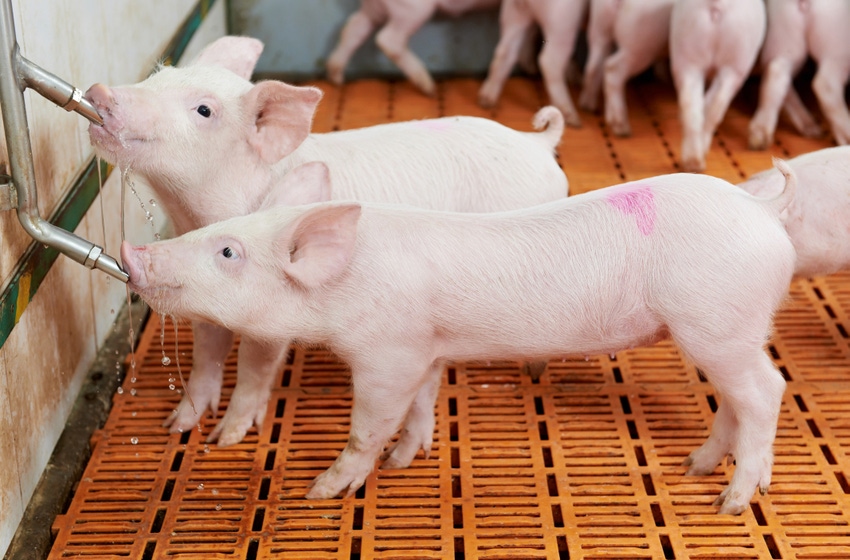Global 2020 pork production projected to fall 10%
ASF continues to ravage Asian countries, with recovery not expected until late 2020.

Global pork production is projected to be 10% lower in 2020 due to the impact of African swine fever (ASF) on swine herds in several major pork-producing countries, according to a newly released U.S. Department of Agriculture report.
Most of the reduction in global production can be attributed to a 25% decline in China's pork production, but USDA said production is also lower in the Philippines (down 16%) and Vietnam (down 6%). While South Korea has reported 14 cases of ASF, USDA said the outbreaks have been contained, and no production impact is expected at present.
According to the report, most major pork exporters will boost production in 2020 due to rising global import demand. Production is up robustly in the U.S. (4%) and Brazil (5%). Global exports are forecasted to rise 10% to 10.4 million tons. China imports are expected to be 35% higher and to account for 35% of global pork imports. The Philippines imports are also projected to be 32% higher due to the impact of ASF on domestic supplies.
Currently, exports from the European Union and Brazil are 13% and 20% higher, respectively, mostly due to growth in exports to Asia. In contrast, USDA relayed that Canada's exports are down slightly as China's import restrictions limit opportunities for growth.
USDA said U.S. production is forecasted to be 4% higher in 2020 on increased slaughter and heavier carcass weights. Exports have the potential to increase because companies like JBS USA and Tyson Fresh Meats recently announced that they will be phasing out the use of ractopamine, which is banned by China. U.S. exports are currently 11% due to robust demand from China, improved sales to Mexico and steady demand from Japan and Korea, USDA noted. Also, although retaliatory tariffs remain in place on U.S. pork exports to China, USDA said tariff exemptions and high Chinese pork prices are expected to boost sales in the second half of 2019 and 2020.
Specific to China, USDA agricultural economist Lindsay Kuberka noted that Chinese pork prices have reached record highs, causing an extensive reduction in the pork supply.
“By the end of 2020, China's total swine herd is forecast to decline to 275 million head, down nearly 40% since the beginning of 2018, before the [ASF] crisis began. Many producers have exited the industry, and others are reluctant to restock due to ongoing disease risk,” Kuberka said.
Pork production is projected to decline 25% in 2020. As such, lower domestic supplies are expected to drive demand for foreign pork, resulting in record imports. However, Kuberka said consumers will feel the pinch of lower pork supplies, with a 32% decline in per capita pork consumption over two years.
Prices on the rise
China's Ministry of Agriculture & Rural Affairs (MARA) reported Oct. 12 that the country's hog inventory levels fell 41.1% in September compared to September 2018 as the result of the continued spread of ASF. A survey of hog farms in 400 counties also showed that the sow inventory declined by 38.9% in September, MARA said.
Kuberka said lower hog supplies will have a major impact on pork supplies through at least 2020, and a key question moving forward is how quickly producers can begin restocking.
“Since ASF emerged, producers have liquidated their breeding herds, and many have exited the industry,” she said.
According to the USDA report, market hog prices during the first half of 2019 hovered around the five-year average, but prices began to accelerate in June, rising from an average of 15 renminbi (RMB) to more than 20 RMB in August as hog supplies withered. Prices peaked during the first week of October at nearly 28 RMB, generating record average profits of more than 1,500 RMB/head, USDA reported.
“The possibility of record profits for both breeders and finishers is a strong motivation to restock and increase production. Yet, despite profits, the continued presence of ASF and high level of liquidation assure a long road to recovery for the industry,” Kuberka said.
Still, the Chines government has made production expansion a priority, encouraging provinces to set production targets and facilitate sector expansion. USDA reported that measures introduced by provincial governments include insurance subsidies, higher indemnity payments, subsidized interest rates and other forms of production assistance. Local governments have also been ordered to shorten the start-up time for new farms and facilities by making land available and speeding up permitting. Local authorities have also been instructed to ease up on environmental regulations that limit where farms can be built, a reversal of policy over the last four years that had made building new hog farms difficult or impossible in many regions. However, Kuberka said pollution concerns remain a limiting factor on expansion.
Production growth is likely to be uneven among farm sizes, according to the report, although large producers have already stated ambitious expansion plans. The central government has also announced subsidies and earmarked loans that can cover up to 30% of construction costs and equipment purchases by large hog farms through 2020. Prior to ASF, however, about half of all hogs were produced by farms with less than 500 head, USDA noted. As such, expansion is likely to be offset in the near term by continued declines among smaller-scale farms.
Further, crackdowns on swill feeding, rising costs for biosecurity and manure handling investments and worries about disease will be barriers to the return of individually operated farms, Kuberka suggested.
Pork in short supply
Lower hog supplies will drive a substantial decline in China's pork production — down 14% in 2019 and down 25% in 2020. However, pork consumption is also expected to plunge during 2019 and 2020, USDA said.
“Since the initial outbreak, demand for pork has fallen,” Kuberka said. “Many consumers began to shift away from pork, even though ASF poses no risk to human health.”
USDA said industry contacts observed a roughly 15% decline in consumption in Beijing, China, during the first half of the year, with much of the decline attributed to voluntary shifts from pork to other proteins. Additionally, foodservice operators tried to minimize exposure to pork price inflation by substituting other proteins like poultry meat.
USDA reported that plentiful pork supplies and lower demand kept prices in abeyance for the first half of 2019, but as supplies have declined, pork prices have spiked. The national average pork price published by MARA reached 43.4 RMB during the first week of October — 84% higher than the same week last year.
“While consumer concerns about the disease risk may have impacted pork demand earlier in the year, steeper prices are likely to be the key factor going forward,” Kuberka said. “Consumers have reacted to high pork prices by cutting back purchases and pork prices are expected to reach record levels through the peak demand season — autumn holidays and Chinese New Year.”
The Chinese government is expected to release supplies from the national pork reserve during this period to offset prices.
“Higher pork prices will encourage consumers and foodservice operators to purchase more poultry, beef, lamb, seafood and other proteins, offsetting some -- but not all -- of the drop in pork supply,” she said.
USDA said retail prices for competing proteins are rising as a result, however, with chicken meat up 24% and beef 20% year over year during the first week of October. Chicken meat is expected to benefit from the biggest boost in demand, given that prices remain well below the cost of pork, while substitution to beef and lamb will be more limited since their prices are close to double that of pork.
Imports at record levels
Pork imports are forecasted to reach 2.6 million tons in 2019 and 3.5 million tons in 2020. If realized, imports would account for 9% of consumption in 2020, the highest percentage on record, USDA noted.
“Due to the size of the Chinese market, imports will only partially offset the decline in domestic supplies,” USDA said. “The boost in import demand will increase global exports to a record high of 10.4 million tons in 2020. The gain in demand will lift global prices of pork and crowd out demand from price-sensitive markets.”
USDA reported that China's imports through August 2019 have risen 40% and are projected to be 67% higher for the year.
While the U.S. is well positioned to boost shipments to China given robust growth in domestic production, USDA said retaliatory tariffs are limiting demand from Chinese buyers.
China's imports from Canada during the first half of the year were up 51%, and Canada's 15% market share was the highest of any exporter after the EU. However, USDA said trade collapsed after China placed a restriction on imports of Canadian beef and pork in early June. USDA said imports from Canada are expected to fall to zero through the duration of the ban.
Brazil's exports to China are up more than 30% through August, but the country is also constrained by facility approvals that limit eligible product.
The EU is currently the biggest winner, with shipments to China up 39%. USDA said the EU is expected to remain the top supplier to China, with a 61% market share year to date, but is also limited due to a combination of factors: weak domestic demand, ongoing ASF in several member states and environmental regulations that have constrained growth.
ASF impacts to persist
Production in China is expected to be affected through 2020 as a result of both direct losses from ASF and indirect losses from herd liquidation.
“The timing and speed of recovery is highly contingent on the ability of producers to protect themselves, but abilities to control the disease will likely be hampered by the lack of an effective vaccine,” Kuberka said.
With hog prices on the rise, record profits are likely to spur many producers to re-enter the market later this year, but further outbreaks are likely, she added.
“The national government has announced several initiatives to increase pork production. While many of these may help to spur expansion, efforts remain anecdotal and will likely have little impact on industry recovery until late 2020 at the earliest,” Kuberka said.
Market recap
December live cattle futures contracts posted small gains this week, closing higher Monday at $113.45/cwt. and Thursday at $114.375/cwt.
November feeder cattle futures started the week higher but fell as the week progressed. Contracts closed higher Monday at $146.075/cwt. but fell to $144.325/cwt. by Thursday’s close.
Beef cutout prices were mixed this week but higher than the prior week. The Choice cutout closed lower Thursday at $218.11/cwt., while the Select cutout closed higher at $192.60/cwt.
Despite a rally on Tuesday, December lean hog futures were mostly lower this week. Contracts closed lower at $69.125/cwt. on Monday but higher Tuesday at $72.125/cwt. However, the gains couldn’t be sustained Thursday, and contracts closed lower at $68.15/cwt.
The pork cutout was mixed this week, with the wholesale pork cutout closing at $76.28/cwt. Loins were higher at $70.93/cwt., while hams were lower at $61.98/cwt. Bellies closed at $124.82/cwt. down from $141.46/cwt. the prior week.
Hogs delivered to the western Corn Belt were higher, closing Thursday at $59.41/cwt.
The U.S. Department of Agriculture reported the Eastern Region whole broiler/fryer weighted average price on Oct. 11 at 76.48 cents/lb.
According to USDA, egg prices were steady, with a steady to firm undertone. Offerings were light to moderate. Supplies were moderate to fully sufficient. Demand was moderate to fairly good.
Large eggs delivered to the Northeast were unchanged at 65-69 cents/doz. Prices in the Southeast and Midwest were also unchanged at 68-71 cents/doz. and 56-69 cents/doz., respectively. Large eggs delivered to California were $1.14/doz.
For turkeys, USDA said the market was steady to firm, and demand was light to moderate. The price range for hens and toms was higher, at 93 cents-$1.02/lb. and 93 cents-$1.01/lb., respectively.
About the Author(s)
You May Also Like





